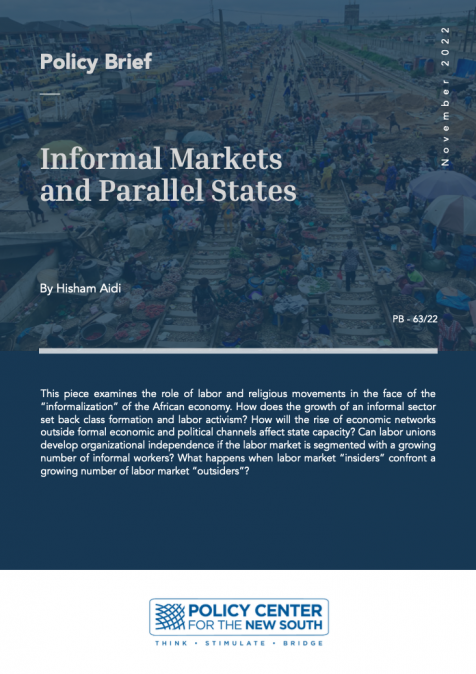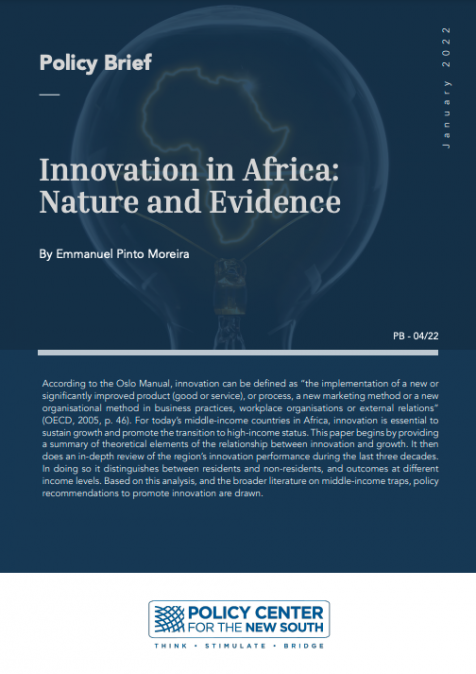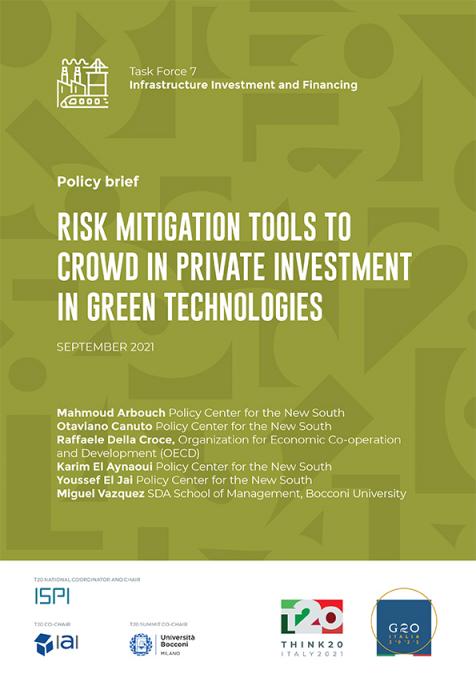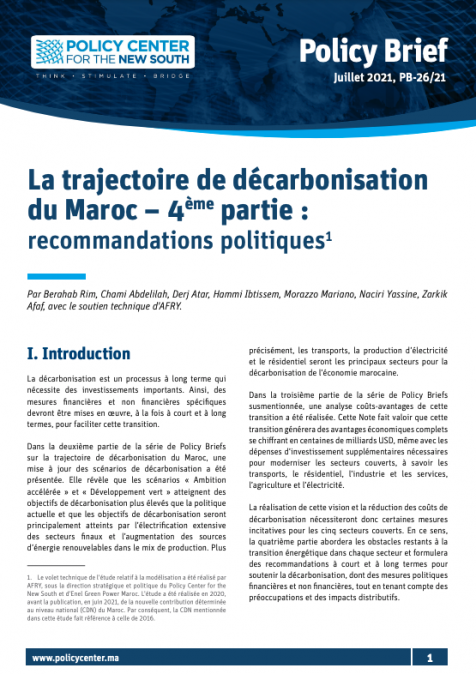Publications /
Policy Brief
This piece examines the role of labor and religious movements in the face of the “informalization” of the African economy. How does the growth of an informal sector set back class formation and labor activism? How will the rise of economic networks outside formal economic and political channels affect state capacity? Can labor unions develop organizational independence if the labor market is segmented with a growing number of informal workers? What happens when labor market “insiders” confront a growing number of labor market “outsiders”?
In his recent book, Black Markets and Militants, the Sudanese political economist Khalid Medani looks at the connection between the informal economic sector and religious movements in Somalia, Sudan, and Egypt.1 He sees the rise of the informal sector in these countries as a result of multiple factors, including the 1970s oil boom, growing outmigration, neoliberal reform and state withdrawal, and the flow of remittances as millions of workers made their way to the Gulf in search of employment. These migrants sent home remittances that were absorbed through an informal banking system with divergent political effects. The author observes, “these capital inflows resulted in the rise of strong autonomous informal economic sectors and altered the socioeconomic landscape of all three countries in profound, but divergent, ways.” Black Markets and Militants is part of a recent body of research that attempts to understand the state's role in the face of a growing informal economic sector driven by religious “trust networks.” A similar study Classless Politics explains the weakness of organized labor in Egypt by pointing to the Sadat regime's attempt to neutralize leftist opposition to his market reforms in the 1970s by shifting public discourse and organizational space from the issue of economic policy to the realm of identity and religion.2 This argument of how an African state pushes religious or identitarian politics to facilitate a neoliberal economic agenda is not new. Luiz Martinez’s classic study of Algeria in the 1990s, similarly detailed how, for a brief period, there was an alliance between reformers in the regime and the Islamist Salvation Front’s (FIS) leadership., A brief dalliance between “globalizers” and “moralizers” until 1991 when the latter called for a general strike.3
This lecture examines the role of labor and religious movements in the face of the “informalization” of the economy. How does the growth of an informal sector set back class formation and labor activism? How will the rise of economic networks outside formal economic and political channels affect state capacity? Can labor unions develop organizational independence if the labor market is segmented with a growing number of informal workers? What happens when labor market “insiders” confront an increasing number of labor market “outsiders”?4
Reform and Labor
The Tunisian General Labor Union (UGTT) is widely viewed as one of the more powerful labor federations in North Africa, having played a pivotal role in Tunisia’s politics since independence, including in the country’s recent transition to democracy. Analysts have disagreed on the UGTT’s independence, some underscoring the organization's internal democratic procedures, and others view it as an organization that extirpates dissident voices deemed threatening by the state. As analyst Ahmed al-Sholi has shown, the UGTT provided refuge to protesters from security forces during the 2011 uprisings. It also played a central role in negotiating with the post-Ben Ali regime and pressing for the constitutional assembly's election.5 The UGTT lobbied for more employment in the public sector, pushing for a wage hike and insisting on the inclusion of social and economic rights in the
Constitution. Even with Kais Saeid’s recent power grab – a move admittedly supported by broad segments of Tunisian public opinion- analysts still think the UGTT can positively push for a return to democratic rule.
Scholars trace the Tunisian General Labor Union ‘s rather exceptional status to the 1970s, when Tunisia's business elite adopted an investment strategy of export-led growth based on a capitalist industrial configuration, which granted Tunisian labor a degree of structural leverage unseen in the region.6 The UGTT would thereafter develop grassroots power, even when based in so-called strategic sectors. As Ahmad al-Sholi observes, “Workers are able to deepen the wedge between business elites and state elites and extract concessions from both.” The UGTT’s role, however, is increasingly complicated by the emergence of a “non-syndicalized” protest movement, as a recent study of informal workers in the town of Redeyf has shown.7
Algeria’s labor movement has historically been politically constrained, though ironically, the recent protests and COVID lockdown have allowed Algerian trade unions to regroup. In March 2019, workers took to the streets of the Algerian capital, launching a massive strike against the Bouteflika regime. Most studies of the political effect of the pandemic have observed that authoritarian regimes used the lockdown to restrict social protest and political activism. Yet by one account, the lockdown in Algeria allowed workers to strengthen their “protest mobilization,” to adopt new tactics for grassroots organizing, and to reframe their grievances against the government.8
Medani’s account shows that as structural adjustment and privatization began in Egypt, and the state began withdrawing, Islamist groups would fill the organizational void left by the regime. Islamist networks and movements flourished providing myriad service. This process played out differently in Sudan, Somalia and Egypt, given each country's specific configuration of state-society relations. In Sudan, Omar Bashir aggressively tried to control these “Islamic” rents and to exclude political adversaries from accessing the cash flow. But the “monopolization of informal financial markets and Islamic banks by a coalition of a newly emergent Islamist commercial class and mid-ranking military officers” would also empower the Muslim Brotherhood in Sudan.9 Access to the funds from Islamic financial institutions allowed Islamist ideologues like Hassan al-Turabi to advance his Sharia project and for the Islamic movements to overpower Bashir’s sclerotic regime. In Egypt, on the other hand, in their attempts to implement market reform, Sadat and Mubarak supported Islamic financial institutions and the Islamist bourgeoisie, which financed the grassroots organizations delivering social services. This Islamist bourgeoisie would become the center of the informal economy that emerged parallel to the formal economy.
Informal Capacities
In Somalia, labor remittances gave rise to a different informal economy. The lack of official banks and publicly-registered enterprises meant that the parallel economy was driven by personalistic networks and clans, whose power exceeded that of the state. Recent studies show that the hawwalat (the informal remittance and banking system) and the flow
of remittances actually reinforced clan divisions rather than Islamist networks, rather than fueling the rise of an Islamist coalition, as happened in Egypt and Sudan. Egypt and Sudan have what could be described as “modern commercial sectors,” while Somalia has more of a pastoralist economy, which means that the remittances would gave rise to parallel markets revolving around foreign currency exchange as well as parallel markets related to livestock trades. The author writes, “in Somalia, informal economic activities in the context of far weaker state capacity coalesced around clan cleavages setting the stage for the complete disintegration of the state.” Somalia is often given as an example of a failed state. Before examining how an informal economy could emerge in a disintegrated or failed state, it is worth recalling that this concept is highly contested.
As a way to measure state capacity, the “Fund for Peace,” for instance, maintains that if a state has lost control of its territory and does not have a monopoly over the use of physical force – that qualifies as “state failure.”10 Harvard scholar Robert Bates also speaks of a state’s declining capacity to control its territory – but sees state failure more specifically as “the implosion of the state,” where the bureaucratic apparatus becomes an “instrument of predation.”11 In his study “States at Risk” (2006) Ulrich Schneckener has proposed a “stage model” as a way to operationalize “state failure,” contending that state formation should include three ingredients (monopoly of violence, legitimacy, and the rule of law) with the former (monopoly on violence) a precondition for the emergence of legitimacy and rule of law.12 He has also proposed four types of statehood: consolidated or consolidating states – where the basic functions of government are working; weak states -where the government has a monopoly over means of violence, but its legitimacy is strongly challenged and the rule of law is uneven; and failing states; and finally, failed and collapsed states, where the state cannot supply governance and sub-national groups (and sometimes external actors) are providing order.
Critics have observed that the “failed state” label is a top-down moniker pinned on to non-Western states deemed non-compliant. The concept of “state failure” also remains wedded to Max Weber’s Eurocentric understanding of the state. The conventional definition is anchored in a historical European context and cannot serve as an exclusive standard. As Joel Migdal has observed, “Actual states are deviations from the ideal or corrupted versions of the ideal.”13 A more instructive way of understanding the Central African Republic or Congolese state should be by focusing on the ongoing negotiations over power and authority between state and societal actors – the “contending coalitions that have cut across both” – state and society – “and blurred lines between them.” The role of ostensibly peripheral actors – like warlords and chieftains – is critical in this process. In this field of study, Warlords are generally viewed as competing with and challenging the weak state since they possess the three building blocks of state power - coercion, capital, and connection; but these very assets can also be deployed on behalf of a national governance project. The very process of negotiation and contestation whereby peripheral actors – rebels, warlords, “mini-states” – are brought into accommodation is what constitutes state- building. Recent analyses of Somalia’s embattled state structures and financial flows adopt this approach.14
The absence of a state does not necessarily produce chaos; rather, it reveals alternatives to state authority. When the state disintegrates – religious organizations, clans, “tribes” and various actors can supply governance, and even fragments of the state may continue to deliver public goods. The authors of the recently published study, “Negotiating Public Service in the Congo,” observe that the Democratic Republic of Congo is often termed a failed state. Yet, even in a conflict-ridden area like Kivu province, local government still provides services, often through a “bottom-up financing” and informal taxing of citizens. As Titeca and Herdt write, “The DRC state continues to exist from the bottom upwards, through local-level arrangements rather than engineered from above.”15 In short, African state institutions may lack a monopoly on violence, chain of command enforcement and top-down capacity, but that does not mean people live in a state of incessant war. When the state is absent – think Somalia - people have joined movements and organizations that provide security, services, and even “sub-national conceptions of citizenship.” How to theorize this splintering of authority, this hybrid form of governance, where the central state is supplanted by localized arrangements that allow public services to be delivered? What exactly is “rebel governance” or “counter-state formation”?
Scholars have argued that in weak African states leaders fear that institution-building and the establishment of a strong military could threaten their political survival. rRulers will prefer to rely on personalist networks to govern – that way depriving rivals of an alternative power-base. The African leaders’ fear of military coups is not unfounded. In sub-Saharan Africa, between 1956-2001, 42 out of 48 countries, experienced coups. Thirty countries (62.5%) experienced successful coups and eighteen (37.5 percent) experienced various successful coups.16 In this context, leaders see institutional development as risky and prefer to rely on patronage networks. Thus, after the Somali military attempted to overthrow Siad Barre in 1978, the president abandoned efforts to build a socialist-style state and began relying on patronage networks and personal ties. Similarly, in Sierra Leone, in the late 1970s, after an attempted coup, president Siaka Stevens would begin creating paramilitary groups, allowing allied politicians to protect diamond mining areas around the country. The privatization of violence had a deleterious effect on state-building and the provision of security as a public good for Sierra Leoneans, but it was a survival strategy for a ruler who had survived two coup d’etats (surviving the second only with the assistance of troops from neighboring Guinea.) The central aim of the personal rule is to prevent unity and coalition-building among the country’s political elite, by sowing a fractious politics and keeping elites dependent on the ruler’s largesse. As William Reno writes, “This system of governance through the manipulation of an alternate non-institutional realm of personal networks and tight control over people’s access to economic opportunities is terrible for the overall economy,” but it can maintain stability as long as the ruler has a tight grip over these patronage networks.17
Informal institutions are also the source of social and economic resilience. As political economist Steve Heydemann recently argued, informal institutions (solidarity-based social mechanisms) may also be responsible for the comparatively low level of extreme poverty in the North Africa and Middle East (MENA) region. It is a paradox that the MENA region, where economic grievances run high, has historically one of the lowest levels of extreme poverty in the developing world; measured by the number of people living on less than $1.90 a day, the current International Poverty Line (IPL). According to this argument,
remittances and state-sponsored cash transfer programs play a role too, but remittances vary in consistency, and cash programs (like Takaful in Egypt) are rather recent and pale in the face of the localized, informal trust-based institutions that offer support to the very poor. In Markets of Dispossession, Julia Elyachar submits that “The informal economy and the ability of the poor to survive without help from the state, had at their core social networks built around community reservoirs of trust.”18 In the decade since the so-called Arab Spring began, poverty has sharply risen in the MENA region due tothe conflict and unrest. World Bank data shows extreme poverty rising (starting in 2015), such that the MENA region has overtaken Latin America, a trend exacerbated by the COVID pandemic. What these numbers suggest, writes Heydemann, “is that a concerted effort will be needed once the pandemic recedes to support the restoration and repair of the social bonds and social solidarities that play a crucial role in sustaining the economic resilience of the least well-off in the MENA region.”19
“A Hopeful Continent”
The discourse of state failure is, of course, intertwined with the Afro-pessimist narrative about Africa being “growth resistant,” a narrative memorably showcased by The Economist magazine’s cover from May 2000 that spoke of “The Hopeless continent.” Recently this simplistic narrative has been subjected to powerful critiques, most prominently in the work of economic historian Morton Jerven, who in his book, Poor Numbers (2013)20 argues that while it's true that African economies generally grew more slowly than other regions from the mid-1960s to the mid-1990s, the idea of “slower growth” as an average is only true for the 90s. “It is not true that African economies grew more slowly on average in the 1950s, the 1960s, the 1970s, and the 2000s,” writes Jerven.21 One historian would observe that this “slow growth” narrative put forth by a number of Western economists suffers from a “compression of history” that is in not distinguishing between periods of history, the causal argument is obfuscated and oversimplified.
Historians also look at the long-term explanations for weak institutions. State fragility and political violence resulting from state breakdown have been traced to colonial policies, in particular the “bifurcated states” and dual legal systems introduced by colonialists which “compartmentalized” societies and divided social groups into antagonistic “ethnicities” and “races” with differing rights. But state failure is also rooted in post-colonial authoritarianism. “Personalist” styles of rule where the state leadership deliberately fragments and disorganizes society and institutions, where “disorder is a political instrument,” can set the stage for a multi-sided civil war.22 Personalist rule – as seen in Zaire and Somalia during the Cold War, eventually spawned a conflict pitting various armed groups against each other, where the aim was not to build a counter-state in a “liberated zone,” but rather to control commercial and social networks.23 Others have noted that “rebel governance, at a minimum, means the organization of civilians within a rebel-held territory for a public purpose.” Insurgent rule, in this perspective, tends to occur when the central government is predatory and suffering from an acute legitimacy crisis. And rebel governance is not an African phenomenon.
The Cold War affected state capacity in myriad regions. In Latin America, insurgent rule emerged in the wake of rebellions and civil wars. In Colombia, the FARC established rudimentary taxation institutions, separate schools, courts, providing protection to cocoa growers, and even literacy classes for the indigenous population. The symbolic dimensions of rebel governance can be as critical as institutional mechanisms for consolidating a nation-state. As one analyst has observed of South Sudan and Côte d'Ivoire, “symbolic processes reduce the need for a rebellion to use force to ensure compliance; in addition, they may increase civilian identification with the rebel government”24 Along these lines, recent research on armed groups in eastern Democratic Republic of Congo concludes that the Mai-Mai rule not through direct imposition or territorial control, but by shaping people’s identity, subjectivities ad self-conduct. The Mai Mai may have partial territorial control but, lacking the administrative instruments to govern, will employ a form of “governmentality,” and techniques of rule that mixe protection with patronage, spirituality with “stateness,” ethnicity and custom.
In addition to a critical take on colonial legacies, another critique of the stagnant Africa narrative looks at intra-African trade, noting that regional trade agreements on the continent have boosted intra-African exports by 27% to 32%.25 A recent IMF report notes that until the pandemic, economies in Sub-Saharan Africa grew at impressive rates. Ethiopia and Rwanda grew at an average of 7.5% per year over the last 20 years. Using satellite images of the Earth's nighttime lights as an indicator of economic activity, researchers contend that until 2020, African states made significant progress in lessening regional income equality, that is differences in output per capita across regions of a country; the greatest reductions in regional inequality occurred in oil exporters and frontier markets like Ghana and Kenya.26 This growth was mainly the result of the improvement of infrastructure. The regions that did not see growth were areas where you had fragile or conflict-ridden states. Stark disparities remain in Burkina Faso; for instance: the wealthier regions have 20 times more access to electricity. Before the pandemic. This growth, the authors conclude, was due to various factors - macroeconomic stability, trade openness, strong institutions of political stability and well-directed investments.
International financial institutions are also paying greater attention to the informal sector, which provides an estimated 80% of jobs on the African continent, especially for the young. The pandemic adversely affected informal workers' livelihood in several countries, particularly in urban areas. According to a World Bank study carried out between April and June 2020, 56.3% and 29.4% of respondents in Nigeria and Uganda claimed that they were deprived of work as compared to 39.2% and 11.1% in rural areas.27 The IFIs are also a concluded the best way to assist the informal sector (workers and merchants) in times of crisis is through cash handouts. However, other social protection instruments are being introduced as well (for example, pensions, and disability support). It is encouraging that international financial institutions realize that Africa’s informal sectors are critical to the continent’s economic and political development and also merit social protection.
- https://www.cambridge.org/core/books/black-markets-and-militants/8C7CE1BFFBE59EE246354403126B7F58
- https://cup.columbia.edu/book/classless-politics/9780231203258
- https://cup.columbia.edu/book/the-algerian-civil-war-19901998/9780231119962
- Chantal Berman , “Who are unions for? Snapshots of union-activist relations in Redeyef, Tunisia, in the late Ben Ali era,” https://pomeps.org/who-are-unions-for-snapshots-of
- Ahmad Al-Sholi , “The Many Leverages of Tunisian Labor” https://pomeps.org/the-many-leverages-of-tunisian-labor
- https://www.routledge.com/Trade-Unions-and-Arab-Revolutions-The-Tunisian-Case-of-UGTT/Yousfi/p/book/9780367885045
- https://pomeps.org/who-are-unions-for-snapshots-of
- Ashley Anderson, “COVID-19 and Algeria’s Labor Movement,” https://pomeps.org/covid-19-and-algerias-labor-movement
- “A new political economy of Islamism,” https://abuaardvark.substack.com/p/a-new-political-economy-of-islamism
- “Fragile States Index 2019,” The Fund for Peace (2019)
- https://www.annualreviews.org/doi/abs/10.1146/annurev.polisci.11.060606.132017
- https://www-swp--berlin-org.translate.goog/en/publication/states-at-risk?_x_tr_sl=de&_x_tr_tl=en&_x_tr_hl=en&_x_tr_pto=sc
- https://www.cambridge.org/core/books/state-in-society/EE7F2D0E3C5EFCA1F1210C120FC1B7B8
- https://www.tandfonline.com/doi/abs/10.1080/02589001.2020.1774522?journalCode=cjca20
- https://theconversation.com/failed-state-how-the-drc-continues-to-deliver-public-services-122055
- Paul Collier, “Coup Traps: Why Does Africa Have So Many Coups D'Etat?” (Oxford University 2005)
- https://direct.mit.edu/daed/article/146/4/139/27173/Fictional-States-amp-Atomized-Public-Spheres-A-Non
- https://www.dukeupress.edu/markets-of-dispossession
- https://www.brookings.edu/blog/order-from-chaos/2021/03/02/in-the-middle-east-poverty-is-down-but-economic-grievance-is-up-why/
- https://www.cornellpress.cornell.edu/book/9780801478604/poor-numbers/
- https://www.phenomenalworld.org/analysis/pessimistic-growth/#fn:12
- Patrick Chabal and Jean-Pascal Daloz, Africa Works: Disorder as Political Instrument (Indiana University Press 1999)
- https://direct.mit.edu/daed/article/146/4/139/27173/Fictional-States-amp-Atomized-Public-Spheres-A-Non
- https://www.cambridge.org/core/books/rebel-governance-in-civil-war/C40247AED4FA30DC2704EB64EA5CFFD5
- Andrew Mold, “The economic significance of intra-African trade—getting the narrative right, “ https://www.brookings.edu/research/the-economic-significance-of-intra-african-trade-getting-the-narrative-right/
- Habtamu Fuje and Jiaxiong Yao, “Africa’s Rapid Economic Growth Hasn’t Fully Closed Income Gaps,” https://www.imf.org/en/Blogs/Articles/2022/09/20/africas-rapid-economic-growth-hasnt-fully-closed-income-gaps
- https://blogs.worldbank.org/africacan/supporting-africas-urban-informal-sector-coordinated-policies-social-protection-core










